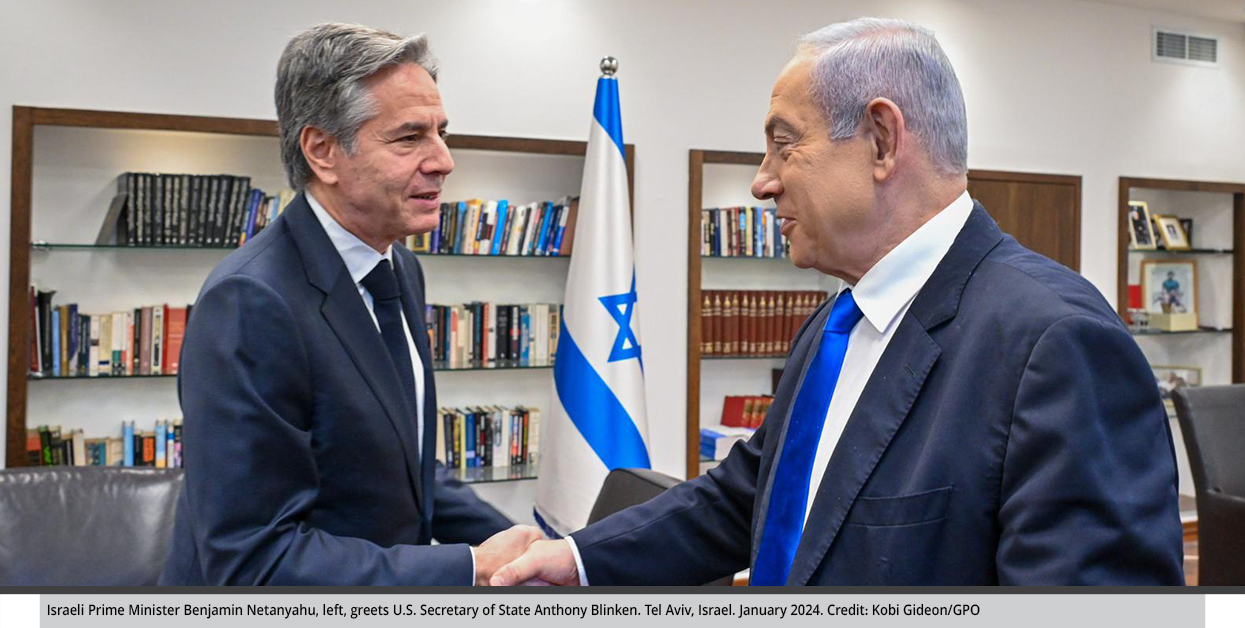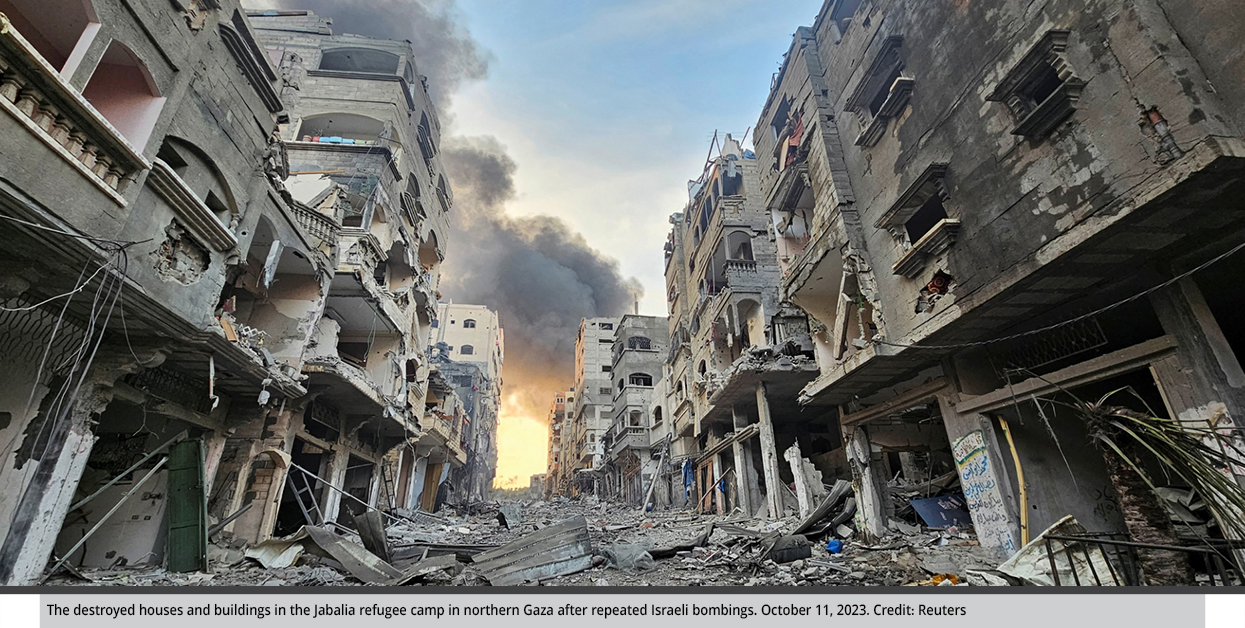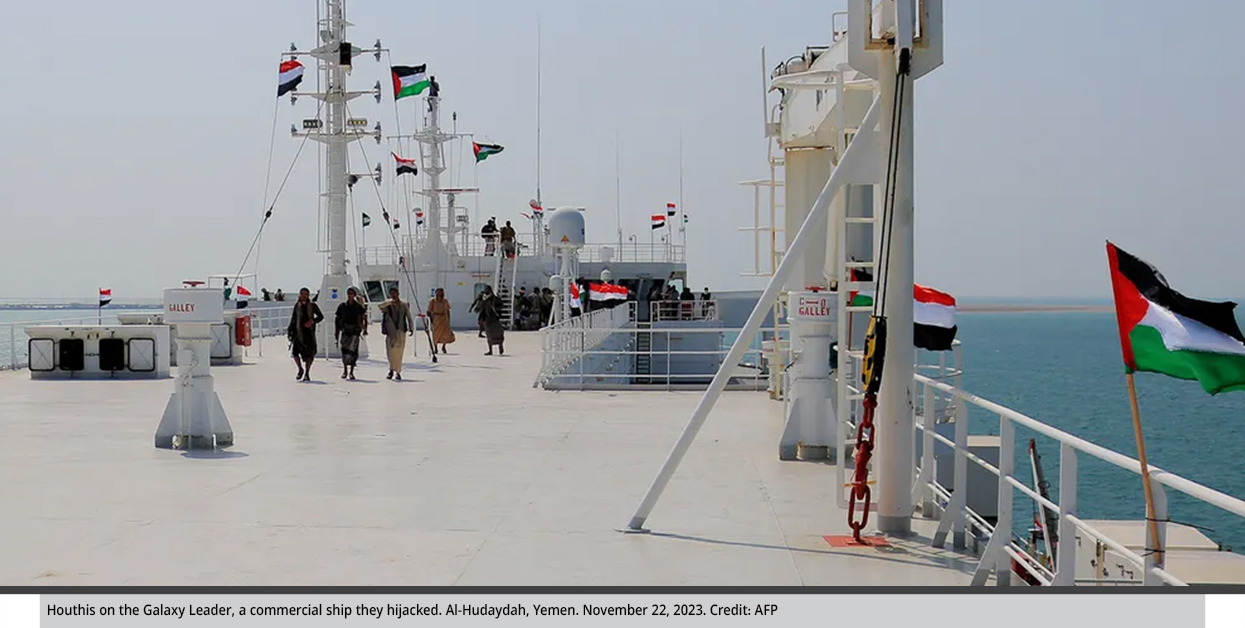The United States: The De-Escalation Efforts and the Prospects of Escalation in the Middle East
Policy Analysis: This paper discusses the United States policy and pillars towards the war in the Gaza Strip, and the U.S. position on the secondary arenas of escalation. It also presents a new idea about the signs of independence of those arenas in terms of their goals and objectives from the main arena of war in the Gaza Strip, the matter that poses new challenges for the United States in pursuing unified policies.
by STRATEGIECS Team
- Release Date – Jan 18, 2024

Right from the first day of the war in the Gaza Strip, the United States has set its priorities: supporting Israel militarily and diplomatically, preventing the war from spilling beyond Gaza, stopping it from escalating on a regional level, and discussing a post-war stage that includes unifying the governance in the West Bank and Gaza Strip.
The war posed a challenge to the American goal of consolidating calm in the Middle East while avoiding direct military interventions in the region’s issues and files. At the very least, the war has restored the strong contact of the United States in the region. Most experts believe that the decision to stop the war will be decided by Washington, and that its military build-up and diplomatic visits will help prevent the war from sliding into a wider regional conflict. Thus, the tracks of controlling the war and the possibilities of escalation during 2024 are subject to the United States and its variables.
The Three U.S. Policy Pillars Regarding the War
The Ukrainian crisis became the most important determinant in U.S. foreign policies for most of 2023, with massive U.S. financial and military support channeled to Kiev for counterattacks launched against the Russian areas of control in eastern Ukraine. The Ukrainian crisis was the main point of attention for the United States—until the war broke out in Gaza on October 7, marking a sharp shift in U.S. policies from the European continent towards the Middle East.
The battlefield in the Gaza Strip, and its repercussions in Lebanon, Iraq, Yemen, and Syria, also directly affects U.S. politics, especially the November U.S. presidential election as well as a network of American political and economic interests in the region and the world.
The U.S. positions on the war in Gaza are centered on three strategic pillars, the first of which was rejecting a ceasefire until Israel achieves its goals of eliminating Hamas or at least undermining its administration and influence in Gaza. Whereas Washington had once provided unconditional support to Israel to achieve those goals, such support now appears to be wavering.
The second pillar is the Biden administration’s rejection of Israeli reports and statements regarding changing the map of the Gaza Strip, whether in terms of cutting off parts of Gaza, occupying Gaza, establishing a buffer zone, or displacing Gazan civilians. Instead, the United Satiates presented a vision to revamp the Palestinian Authority (PA) and unifying the governance in the West Bank and Gaza Strip under the PA’s administration.
The third pillar is to prevent the expansion of the war to the West Bank and Lebanon. A regionwide conflict would impede any political settlement that the United States is trying to implement in order to resolve the Palestinian cause. The expansion of the war would also jeopardize the political gains, economic integration plans, and regional calm supported by the United States.
With regional escalation not eliminated (rather, it is postponed), Washington continues to maintain a large military presence in the region even after announcing the withdrawal of the USS Gerald R. Gerald Ford aircraft carrier group from the eastern Mediterranean in early 2024. Meanwhile, the U.S. Navy remains close to the beaches overlooking Israel and Lebanon, and the Biden administration is keen to keep its diplomatic delegations present in the region through Secretary of State Antony Blinken’s continuous visits to the countries in the region.
However, given the nature of the war and its enormous humanitarian costs—almost 26,000 people have been killed and 1.7 million of Gaza’s 2.3 million population has been displaced—the United States seems to be pressing to change the Israeli army’s strategy from constant bombings affecting the civilian population to precision airstrikes against the leaders of the Palestinian factions and Hamas’ military manufacturing complexes, with the aim of avoiding the bitter humanitarian suffering while causing chaos to the Palestinian factions so that they lose control over their various troops on the battlefield as well as the ability to manage the Gaza Strip.
It seems that the November U.S. elections has become a variable in Washington’s position on the war. Blinken’s trip to the region on January 8 indicated how the Biden administration’s position on the war may affect the approaching elections. When Blinken talked during his visit about the readiness of the region countries to invest in the future of Gaza, reviving Saudi normalization with Israel, adopting the discourse of integrating Israel into the region, and emphasizing America’s support for the two-state solution, Blinken was highlighting the administration’s diplomatic achievements and minimizing the war’s possible political repercussions on the U.S. elections.

Paths of Control and the Potential of Escalation
With the continuation of the war in Gaza, the United States maintains its three strategic pillars in the war. However, there are multiple battlefields. The main field is in the Gaza Strip, with secondary arenas in the West Bank, Lebanon, Yemen, Iraq and Syria. This requires Washington to formulate its policies and carefully respond according to the specificity of each of those arenas. But controlling escalation in any of these battlefields is not guaranteed.
First: the Main Battlefield in the Gaza Strip
The United States recognizes that the war in the Gaza Strip is the cornerstone and the main reason for the status of regional escalation. Gaza is the most complicated battlefield, given the ongoing and seemingly unending Israeli military campaign against Palestinian factions that have demonstrated the readiness and stability of their military forces to withstand a long-term battle.
While Washington had insisted no ceasefire is to take place, it is now pressing to change the nature of the war to become less severe, hoping for the return of the displaced to their areas and an increase the humanitarian aid to the people of Gaza. This achieves a set of interests for the Biden administration, including easing international and local pressures to end the war, calming the escalation in secondary arenas, and, most importantly, encouraging regional actors to engage in discussions regarding the next day of war.
At the same time, Israel is being pressed to present a timeline to complete its objectives, but with more precise attacks and fewer humanitarian consequences. However, the path that the United States desires for Gaza, which may affect the Israeli government and the intentions of its parties, may widen the gap between the America and Israel, which means that the war in Gaza will remain in a state of escalation until Israel forms a new government more in line with the vision of the United States regarding the future of the region—and more aware of the nature and limits of strategic relations between Washington and Tel Aviv.

Second: the West Bank
The Biden administration is keen about the continuation of calm in the West Bank and is showing seriousness in imposing its vision of revamping the Palestinian Authority. But it finds itself contradicting the policies of the Israeli government, which aims to weaken the Palestinian Authority as a political and security entity. In fact, since the moment the current government coalition in Israel was formed in late December 2022, the Biden administration has rejected many of its policies. In addition to rejecting Israel’s displacement and occupation plans for the Gaza Strip, Washington opposed the government’s encouragement of settlers in the West Bank. Capitol Hill translated its opposition into pressure and sanctions by announcing in June 2023 that it was re-banning the use of U.S. tax dollars for any research and development or scientific cooperation projects conducted in Israeli settlements in the West Bank, East Jerusalem, and the Golan Heights.
This means that events in the West Bank will remain cautiously escalating, although it may witness partial détente, financially speaking, as Washington is insisting on transferring clearance funds to the Palestinian Authority and calling for easing military measures at checkpoints and in some entrances to quiet cities.
Third: the Lebanese Arena
The Lebanese arena is the most dangerous after the Gaza Strip in terms of likely escalation. It is considered the determinant arena for the state of other arenas regarding regional calm and escalation. Since the early days of the war, the Biden administration was keen to deter Hezbollah from violating the rules of engagement and sliding into a wide clash with Israel. With the removal of the USS Ford carrier group anchored in the Mediterranean Sea to protect Israel, Washington is telling Tehran and its allies that it does not want further escalation. This may indicate that the risks associated with regional escalation are lower than during the first months of the war despite the recent Israeli assassinations of military opposition leaders.
- In late December, Israel killed Radhi Mousavi, a commander in Iran’s Islamic Revolutionary Guard Corps (IRGC), in his home in Syria.
- On January 2, 2024, Israel assassinated the deputy head of the Hamas political bureau, Saleh al-Aruri, and a group of Qassam Brigades leaders in the southern suburbs of Beirut.
- Iran accused Israel of planting the two bombs that killed at least 94 people during a gravesite ceremony on January 3 commemorating the assassination of IRGC Quds Force commander Qassem Soleimani. A few hours later, ISIS claimed full responsibility for the massacre.
- On January 8, Israel assassinated Wissam al-Tawil, an official in Hezbollah’s Radwan Force, with an airstrike directed at his car in his hometown 65 miles away from Beirut.
- On January 8, the Israeli military admitted it had “eliminated” Hassan Okasha, a Hamas official responsible for firing rockets from Syrian territory into Israel.
- On January 9, Israel announced the death of Ali Hussein Bourji, the commander of Hezbollah’s aerial forces in southern Lebanon.
With concern the United States is looking at the statements of Israeli leaders towards the escalation in Lebanon and Israeli actions that all but demand a response from Hezbollah. Reports revealed that Washington warned the Israeli government about any escalation in Lebanon, preferring diplomatic solutions such as the implementation of UN Security Council Resolution 1701, which calls for full cessation of hostilities between Israel and Hezbollah, the withdrawal of Israeli forces from Lebanon, and the disarmament of armed groups including Hezbollah.
The Biden administration realizes that turning the clashes between Israel and Hezbollah into a war similar to 2006 will have significant humanitarian, economic, and political repercussions on Lebanon, perhaps leading to its collapse. On the other hand, the regional conflict is linked to the Lebanese front. Therefore, the Washington is pressing to prevent Tel Aviv from being dragged into reckless military adventures.
Fourth: the Yemeni Arena
With the Houthis expanding their attacks despite repeated warning from the United States and the West, the Yemeni arena, the Bab el-Mandeb region, and the Red Sea have a greater potential for escalation compared to other secondary arenas. On January 9, the U.S. Central Command revealed that the U.S. Navy responded to a complicated Houthi attack of 18 drones, cruise missiles, and an anti-ship ballistic missile in the southern Red Sea. This marked the 26th attack launched by the Houthis since November 19, according to the Central Command.
Unlike other arenas, the Houthi escalation has international consequences that directly threaten one of the world’s most vital trade routes: the Bab al-Mandab Strait that connects the Mediterranean Sea and the Indian Ocean via the Red Sea and the Suez Canal. To protect waterways in the Red Sea from Houthi attacks, the United States announced a 20-country coalition called the “Guardian of Prosperity.”
- On January 3, 14 countries issued a statement holding the Houthis responsible for threatening waterways.
- On January 10, a UN Security Council resolution called upon the Houthis to cease their attacks on ships in the Red Sea.
- On January 11, one day after the Security Council resolution, Washington and London launched a series of precision strikes against Houthi targets in Yemeni cities controlled by the Houthis, including Al-Hudaydah and Sana’a, Yemen’s capital. (Russia and China’s abstention from voting or using a veto against the resolution was interpreted as a green light.)
- On January 18, the U.S. State Department reclassified the Houthis as a terrorist organization.
However, the Houthis are continuing to hijack ships in the Red Sea even after the U.S.-British strikes, the latest of which was on January 17. Thus, the United States responded with additional air strikes against Houthi military assets. Thus, the United States is trying to intensify its military and political pressure on the Houthis with additional airstrikes against its military assets, which is unlikely to have an immediate effect but carries the risk of pushing the Red Sea towards further turmoil.

Fifth: the Iraqi and Syrian Arenas
The Iraqi and Syrian arenas are interlinked in terms of the unity between the armed groups attacking the American forces in both countries .Since the outbreak of the war in Gaza, the two arenas have witnessed a gradual progress of escalation that quickly developed into a cycle of strikes and counter-strikes. It started in earnest on November 22 with a U.S. AC-130J aircraft targeting two facilities of armed groups in Iraq near Anbar and Jurf al-Sakhar and included the U.S. drone strike in early January that targeted and killed Talib al-Saidi, an Harakat al-Nujaba leader and commander of the 12th Brigade of the Popular Mobilization Forces, inside his car in Baghdad.
While the United States claims its strikes were retaliatory and in self-defense, the armed groups in Iraq backed by Iran began the current escalation as a goal that goes beyond solidarity with Gaza or a ceasefire. They want to expel all U.S. forces from Iraq.
Following Saidi’s assassination, the Secretary-General of the Lebanese Hezbollah, Hassan Nasrallah, announced on January 5: “Iraq has a historic opportunity to get rid of American forces.” The Iraqi government then announce it would set a timetable for the exit of U.S. forces from the country, as the strike was considered a dangerous escalation that contradicts the official understandings between Iraq and the international coalition to combat ISIS.
It is possible that armed groups will intensify their attacks to pressure U.S. forces to leave the region by making it an unsafe environment for American soldiers. Ironically, Washington, since the outbreak of the war, has tried to avoid confronting armed groups and Iranian influence on Iraqi territory, limiting U.S. confrontations to Syria. Certainly, the U.S. retaliatory operations and air strikes have put its relationship with the Iraqi government to a test, the consequences of which will appear in diplomatic arenas more than in further attacks and military responses.
Finally, the shifts in the secondary battlefields seem more dramatic and independent than in the main battlefield inside the Gaza Strip. The goals of the secondary arenas gradually moved away from solidarity with Gaza and demanding a ceasefire towards independent goals regarding their own arenas, whether achieved through defensive, retaliatory, or offensive attacks.
This complicates the ability of the United States to proceed with balanced and accurate policies in various arenas. Therefore, the United States sends messages of appeasement to Iran, which continues to assert that its allies have no central connection to Iran, an idea that is marketed to—but not bought by—the international community.

STRATEGIECS Team
Policy Analysis Team
 العربية
العربية